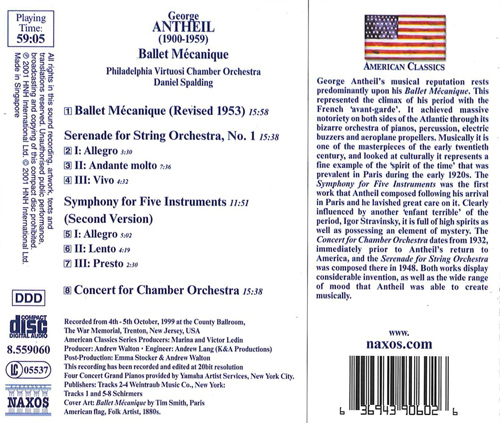New World Records' George Antheil: Dreams, Piano Concerto No. 2, Serenade No. 2 takes the all-Antheil disc out of the realm of his symphonies and recitals of little, short piano pieces into other kinds of major literature that Antheil also produced. Dreams is one of Antheil's most infectious works, a ballet written for George Balanchine that co-mingles waltzes, marches, pop tunes, and even Schumann's The Happy Farmer in a lightly applied and certainly "dreamlike" tapestry as diaphanous as the music it was designed to replace, namely Darius Milhaud's Les Songes. One wonders why Balanchine would want to substitute for music that is as lovely as Les Songes, but there was a concern among émigré artists in the 1930s that their productions might be perceived as "too European" for American tastes. In any event, Antheil did Balanchine proud with Dreams, and it is equally mysterious that they did not work together again.
Just as light and precious is Antheil's Piano Concerto No. 2, though dating from his "futurist" period in the 1920s, is likewise light and colorful, although the harmonic palette in use is more daring. Although largely condemned as "pseudo-Stravinsky" when it was first heard, it is clear that the Piano Concerto No. 2 is a continuation of the ideas Antheil first pursued in Piano Concerto No. 1, except that it doesn't contain nearly as many violent contrasts. Antheil's score for Cecil B. DeMille's The Plainsman helped set the tone for the scoring of movie westerns, and some of that hickory-smoked flavor carries over into his American vernacular onSerenade No. 2, rubbing shoulders with cityscapes, skyscrapers, and lonely walks through dark, rainy alleyways. All three pieces dispense with familiar development schemes and even psychological form in favor of a sort of loose, stream-of-consciousness manner of folding one idea into another, or in making abrupt transitions like "jump cuts" in a movie.
Pianist Guy Livingston, who has done much on Antheil's behalf, is the featured soloist in the concerto, and the whole is performed by the Philadelphia Virtuosi Chamber Orchestra under Daniel Spalding. The recording, made at the First Presbyterian Church of Philadelphia, is good but a little distant, and at times the listener might wish to hear pianist David Hasbrig in Dreams a little better. None of these pieces had been recorded before when this disc was planned, and in the meantime, CPO managed to rush out an Antheil Piano Concerto No. 2 of its own a little ahead of this one. Given a choice between the two, any true Antheilian would want the one with Livingston, and indeed, it is worth the slight wait. Moreover, this is a nicely chosen combination of works that demonstrate that in his youth, Antheil viewed Europe through American eyes, but after his return in maturity, he was seeing America from the perspective of a European sensibility. Uncle Dave Lewis
George Antheil (1900-1959)
1-9. Dreams (28:18)
10-12. Piano Concerto No. 2 (21:40)
13-15. Serenade No. 2 (22:11)
Credits :
Conductor – Daniel Spalding
Orchestra – Philadelphia Virtuosi Chamber Orchestra
Piano – Guy Livingston
28.3.25
GEORGE ANTHEIL : Piano Concerto No. 2 • Serenade No. 2 • Dreams (Philadelphia Virtuosi Chamber Orchestra · Daniel Spalding · Guy Livingston) (2006) APE (image+.cue), lossless
27.2.22
GEORGE ANTHEIL : Ballet Mécanique (Daniel Spalding) (2001) APE (image+.cue), lossless

More About this Recording
GEORGE ANTHEIL (1900-1959)
Ballet Mecanique
Serenade for String Orchestra, No. 1
Symphony for Five Instruments (Second Version)
Concerto for Chamber Orchestra
Conductor – Daniel Spalding
Orchestra – Philadelphia Virtuosi Chamber Orchestra
+ last month
REBEKKA BAKKEN – September (2011) FLAC (tracks+.cue), lossless
September, the fifth album by Norwegian singer Rebekka Bakken, picks up where its Americana-influenced predecessor Morning Hours left off: c...
.jpg)



.jpg)



.jpg)



